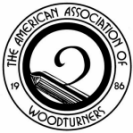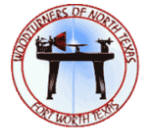|
|
 |
|
|
|
November
2008 Program
|
|
"Shop
critters and natural edge crescent vessels." |
|
presented by Larry Roberts |
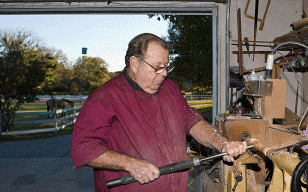 Larry Roberts
is a biologist turned real estate broker. He
owned and operated a large brokerage firm before
retiring in 1995. He served in all offices,
including president, of the Arlington Board of
Realtors. Larry was a board of directors
member of Larry Roberts
is a biologist turned real estate broker. He
owned and operated a large brokerage firm before
retiring in 1995. He served in all offices,
including president, of the Arlington Board of
Realtors. Larry was a board of directors
member of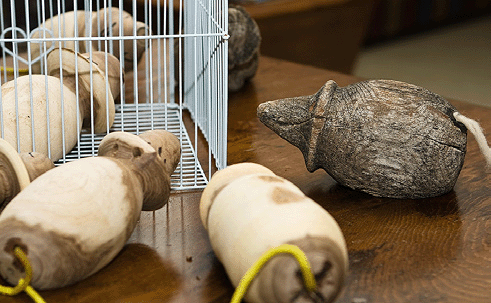 the Arlington Chamber of Commerce and
has served in numerous other volunteer
positions. the Arlington Chamber of Commerce and
has served in numerous other volunteer
positions.
When Texas Turn
or Two (now SWAT) was formed Larry was one of
the first demonstrators and continued to
do so for many years.He has worked tirelessly
behind the scenes helping TTT and SWAT Larry
was involved in some of the first organizational
meetings (only as a wide eyed observer) of
the American Association of Woodturners. Perhaps
he was the first audience.Later he was an AAW
symposium demonstrator. Larry
Roberts is the founding
President of WNTX. Gary Roberts formed the
Central Texas Woodturners Association then in
1989 persuaded Larry to start woodturners group
in
Ft.
Worth. The first
meeting was eight fellows, including Clay
Foster. Clay encouraged design and form
diversity cultivating the individuals
talents.The club grew rapidly and ultimately
spun off the
Dallas group. Now
Texas has 19 woodturning
clubs. Larry has demoed at many of the
Texas clubs.
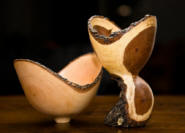 At the next WNTX
meeting Larry will teach you all you need to
know about woodturning by showing you how to
make shop critters. Also shown will be how to
make natural edge crescent vessels. He may even
tell a story or two as he turns. He never lets
the facts interfere with the story. At the next WNTX
meeting Larry will teach you all you need to
know about woodturning by showing you how to
make shop critters. Also shown will be how to
make natural edge crescent vessels. He may even
tell a story or two as he turns. He never lets
the facts interfere with the story.
Enjoy your day.
Larry Roberts
|
|
|
Previous Programs
|
|
|
October
2008 Program
|
|
|
|
Turning Christmas Ornaments |
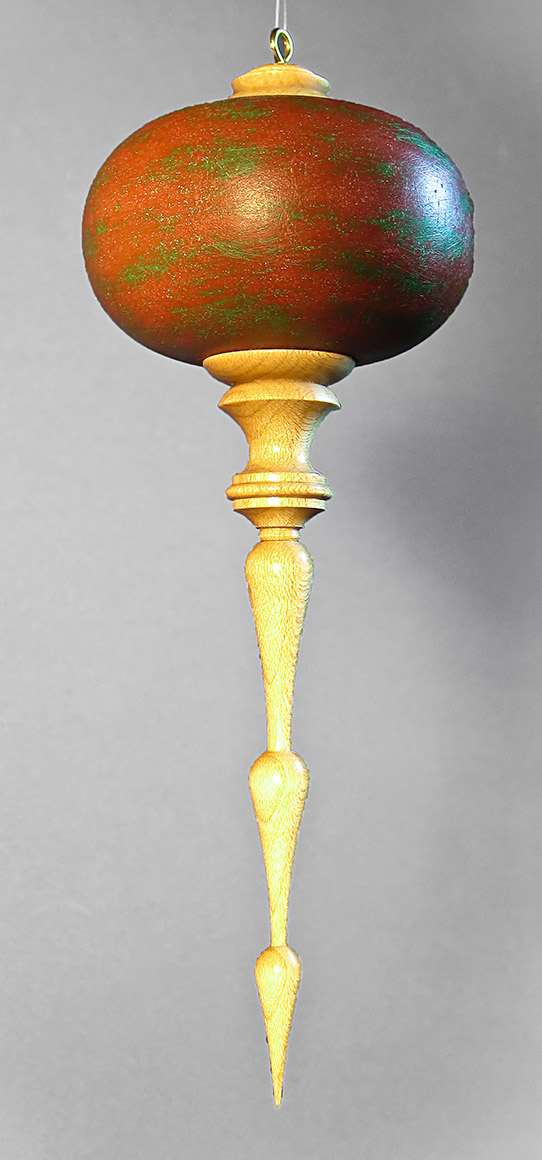 |
|
Brian Evans
|
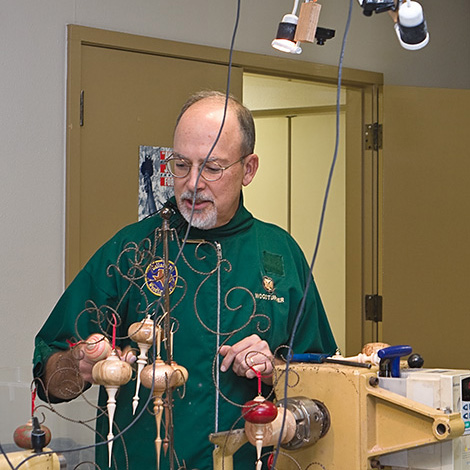 |
|
|
|
|
September 2008 Program
|
|
"Making the Most of Your Mini-Lathe"
|
|
presented by John Horn
|
|
|
|
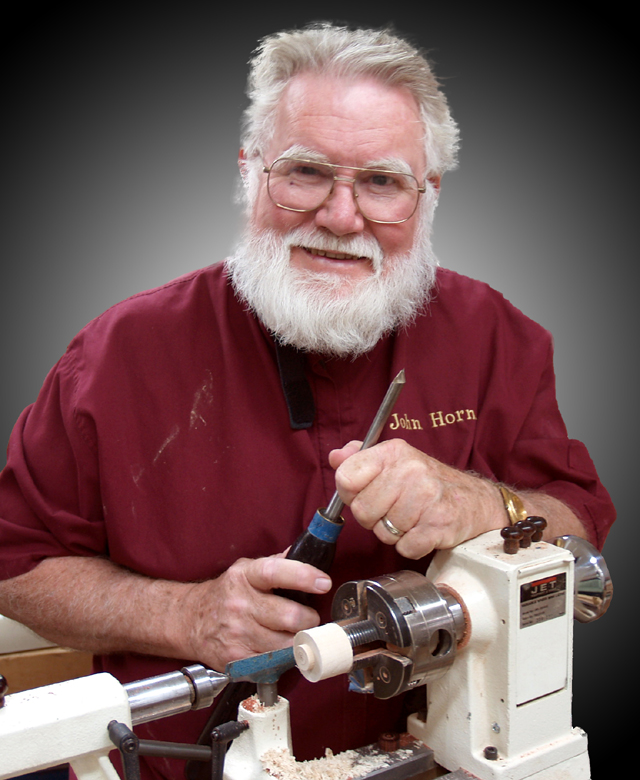 People
with only a mini-lathe sometimes feel they are
handicapped by the size of their lathe.
Others, who have recently added a larger lathe
to their arsenal of power tools, wonder if they
should get rid of their smaller lathe now that
they have graduated to a machine with much more
capabilities. The demonstration will
show the value of owning and using a mini-lathe
for a variety of purposes, no matter whether it
is the only lathe in the shop or whether it is
just one of several lathes that are available. People
with only a mini-lathe sometimes feel they are
handicapped by the size of their lathe.
Others, who have recently added a larger lathe
to their arsenal of power tools, wonder if they
should get rid of their smaller lathe now that
they have graduated to a machine with much more
capabilities. The demonstration will
show the value of owning and using a mini-lathe
for a variety of purposes, no matter whether it
is the only lathe in the shop or whether it is
just one of several lathes that are available.
The demonstration will address
the following questions:
What percentage of a turner’s
desired projects can be handled by a mini-lathe?
What projects can be turned on
the mini-lathe?
What are the limits of a
mini-lathe?
What are the advantages of a
mini-lathe?
What accessories can be fitted to
the mini-lathe to increase it versatility?
What are the sources of extra devices for the
mini-lathe?
Those attending the demonstration
may learn that the mini-lathe is a valuable
asset in the workshop. With careful
thought and assorted accessories, it can
possibly be the most important tool in the shop.
A new appreciation of this small tool and it’s
capacities is the goal of the demonstration.
Each year since 1998 John has
demonstrated for at least three or four monthly
chapter meetings a year for various woodturning
clubs in Texas and Oklahoma. To keep the
audience from becoming bored with his
presentations, he demonstrates on a different
topic every year.
He has demonstrated on the
following topics at Texas Turn or Two and SWAT
every year since 1998 except 2004.
“Turning a Birdhouse Christmas
Ornament”……………..… 1998
“Turning a Santa Claus
Nutcracker” …………………………1999
“Turning a Threaded Lidded Box”
………………………….2000
“Quick and Easy Turned Toys”
……………………………2001
“Woodturning Fundamentals for
Students and Teachers”… 2002
“Taming the Skew”
……………………………………………..2003
“The Art of The Peppermill”
……………………………………2005
“Turning Your Scraps into
Wearable Art” ……………………. 2006
“Tools and Techniques for
Endgrain Turning” ………………. 2007
Educated as an instructor of high
school musicians, John has spent a major portion
of his life teaching a variety of subjects from
high school band and choir to adult computer
applications. Now he teaches regular
classes at the Woodcraft store in Addison and
one-on-one sessions on woodturning topics in his
shop for beginning to intermediate turners.
When he is not teaching and attending
woodturning meetings, he stays busy turning
contract jobs for corporations and individuals
on one or more of his three wood lathes.
A member of the AAW, he is active
in both the Woodturners of North Texas and the
Golden Triangle Woodturners.
|
|
|
|
|
|
|
|
August 2008 Program
|
|
"When Bowls Fly"
|
|
presented by Craig Timmerman
|
|
|
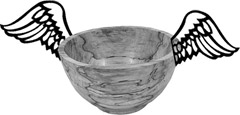
The WNT program on August 28, 2008 will be presented by
professional woodturner Craig Timmerman of Austin,
Texas.
Standard, round bowls are great projects, but when you
want to take your bowls to another level, try giving
them wings! That’s what happens when you take a bowl
blank and leave the corners—you get a bowl with wings.
Non-round bowls are one
 of his signature pieces. He likes to throw in a few
differences such as wings with beads and coves or
interesting shaped pieces such as a rectangle, rhombus,
or even star shapes.
of his signature pieces. He likes to throw in a few
differences such as wings with beads and coves or
interesting shaped pieces such as a rectangle, rhombus,
or even star shapes.
In the August program, Craig Timmerman will cover some
non-round bowl shapes that can be done and will
demonstrate turning a rhombus shaped bowl.
Craig began woodturning ten years ago when he took a
weekend turning class at a local store. After that
weekend the woodworking equipment in his shop ceased to
be used for anything except woodturning.
Craig’s specialties include hollow forms, spheres,
multi-axis work, and non-round (e.g. square) turnings.
His “Swing” series is an example of combining hollow
forms and non-round turnings and his “Alien” vessel
series features multi-axis vases and alien faces.
Production work includes Craig’s “Flying Bowl” series
(a.k.a., square bowls).

Crag works primarily with reclaimed timber—trees that
have come down in storms, trees being taken down for
construction, and the occasional piece of firewood.
Reclaimed timber is often filled with flaws of different
kinds, such as cracks, bug holes, or voids. Rather than
try to remove the flaws, Craig works to accentuate them
by making them the focal point of the piece, filling
them with crushed stone, or carving them into other
shapes.
The demonstration will cover the following topics:
* Chucking options
* Turning “air”
* Using non-round and non-squared pieces for turning
* Light tool touch when turning “air”
* Sanding techniques to use with odd shapes
* Safety concerns when turning non-round pieces
* Getting consistent thickness
* Suggestions on shape and form
* Reverse chucking and tenon removal
 Craig Timmerman is a member of the American Association
of Woodturners and is a firm believer in its mission to
provide education and information to those interested in
woodturning. As such, he frequently demonstrates his
craft. He has demonstrated for many local woodturning
clubs and has twice been a demonstrator at the American
Association of Woodturners national symposium. Craig was
one of the featured lead demonstrators at the 2005
Southwest Association of Woodturners symposium.
Craig Timmerman is a member of the American Association
of Woodturners and is a firm believer in its mission to
provide education and information to those interested in
woodturning. As such, he frequently demonstrates his
craft. He has demonstrated for many local woodturning
clubs and has twice been a demonstrator at the American
Association of Woodturners national symposium. Craig was
one of the featured lead demonstrators at the 2005
Southwest Association of Woodturners symposium.
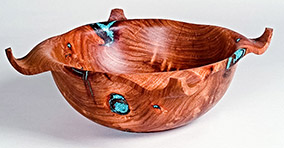 As of June 2008, Craig Timmerman has become a full time
artist. His work is in several central Texas galleries
and can also be found on his website,
www.armadillowoodworks.com. He also does a few
art shows each year. Craig and his wife, Tina, have been
married for twenty-four years and live just outside
Austin. If life wasn’t busy enough, he also sings with
the Heart Of Texas Barbershop Chorus.
As of June 2008, Craig Timmerman has become a full time
artist. His work is in several central Texas galleries
and can also be found on his website,
www.armadillowoodworks.com. He also does a few
art shows each year. Craig and his wife, Tina, have been
married for twenty-four years and live just outside
Austin. If life wasn’t busy enough, he also sings with
the Heart Of Texas Barbershop Chorus.
|
|
|
|
|
|
|
July 2008 Program
|
|
"Segmented Kitchen Utensils"
|
|
presented by Delbert Dowdy
|
|
|
Our demonstrator for July will be Delbert Dowdy who has
been turning for over 20 years. He is a charter member
of the ArkLaTex Woodturners. Delbert has had two
articles published in More Woodturning and
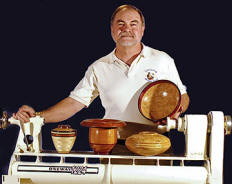 his work appears in two woodturning books. He sells his
work at local fairs and at the Quicksilver Gallery in
Eureka Springs, AR. He has have demonstrated at four
SWAT symposia and will be demonstrating at the SWAT 2008
symposium. His work is primarily pieces that combine
segmentation and solid wood that is pierced, burned, and
colored.
his work appears in two woodturning books. He sells his
work at local fairs and at the Quicksilver Gallery in
Eureka Springs, AR. He has have demonstrated at four
SWAT symposia and will be demonstrating at the SWAT 2008
symposium. His work is primarily pieces that combine
segmentation and solid wood that is pierced, burned, and
colored.
Wooden kitchen utensils can be made easily and quickly
using 3/4 to 1 inch boards of common hardwoods using a
few simple tools. A spatula can be made in twenty
minutes or less and is then ready to use in the kitchen
or put on display. You can use different colored woods
to enhance the look. They sell well and make great
presents.
|
|
|
|
|
|
|
June 2008 Program
|
|
"Making an M&M Dispenser"
|
|
presented by Johnny Tolly
|
|
|
Johnny Tolly of Driftwood Springs, Texas will be our
guest demonstrator for the June 2008 monthly club
meeting. He will be demonstrating how to make his award
winning Peanut M&M candy dispenser. This is a fun
project and when completed makes a very nice gift for
grandchildren and other members of the family.
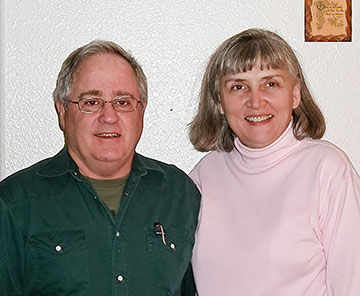 During the program, Johnny will show and explain the
various steps required to make the individual parts.
This includes the dispenser, top, body knob and the
base.
During the program, Johnny will show and explain the
various steps required to make the individual parts.
This includes the dispenser, top, body knob and the
base.
Johnny has been an active wood turner for over
twenty-five years. He is an active member of the
American Association of Woodturners, Southwest
Association of Woodturners, Central Texas Woodturners
Association of Austin, Texas Mesquite Association and
the Artists of Dripping Springs. Johnny is an active
woodturning instructor for others wishing to learn new
skills in the field of woodturning. He has demonstrated
at the Southwest Association of Woodturners symposium
numerous times and at many woodturning clubs around
Texas. Johnny was instrumental in helping one of those
clubs get started. He has also demonstrated at the
Woodcraft Store in Austin and has also instructed
numerous individuals at his home near Driftwood.
Johnny lives near Driftwood outside Austin, Texas with
his lovely wife Marcia. They have five children, Janita,
Johnny, Jimmy, Melissa and Michael. Marcia is Johnny’s’
main inspiration and supporter of his creative
woodturning endeavors.
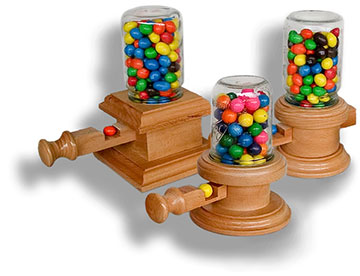 Johnny Tolly has created numerous masterpiece turnings.
He is very creative and has a keen eye for form and
design elements. In addition to bowls, vases and unusual
things like his Texas Sized Big Bug, he has stretched
his imagination and made closed and opened segmented
items as well. They range from vases, bowls, a football,
a globe, table lamps, a floor lamp and bowls with open
segments on the top.
Johnny Tolly has created numerous masterpiece turnings.
He is very creative and has a keen eye for form and
design elements. In addition to bowls, vases and unusual
things like his Texas Sized Big Bug, he has stretched
his imagination and made closed and opened segmented
items as well. They range from vases, bowls, a football,
a globe, table lamps, a floor lamp and bowls with open
segments on the top.
At the Woodworkers show of Austin, Johnny’s globe titled
Johnny’s World Full of Holes placed second and his Texas
Mesquite Floor Lamp placed second the following year.
Johnny has written several HOW TO articles on the web at
http://www.turningwood.com and has had articles
published in the American Woodturner magazine and
Woodturning Design magazine. Some of his work may be
seen at
http://www.ctwa.org in the gallery, at
http://www.woodturner.org and at
http://www.artistsofdrippingsprings.org.
|
|
|
|
|
|
|
May 2008 Program
|
|
"Building a Vacuum Chuck System"
|
|
presented by John Solberg & Pete Tkacs (The Bruised
Brothers)
|
|
|
|
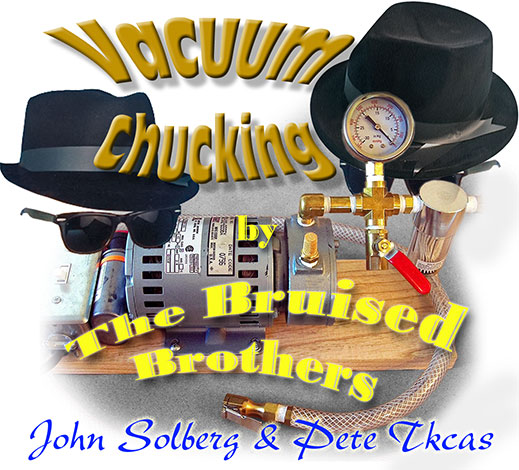
|
|
|
The "Bruised Brothers", John Solberg and Pete Tkacs
became interested in vacuum chucks a couple of years
ago, but were turned off by the expense of purchasing
one. They were determined to build a system and reduce
the cost significantly. After researching other avenues
of parts and supplies, they came up with a system that
functions as well as the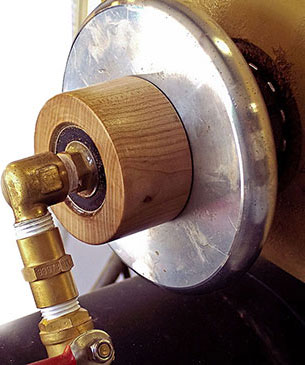 catalog versions
and was considerably less expensive. catalog versions
and was considerably less expensive.
Their demonstration, "Building a Vacuum Chuck
System" will show how to put a system together with
parts and supplies that can be purchased locally or on
the web at very low prices. They will show a variety of
pumps that can be used to supply the vacuum, and will
discuss the pros and cons of each. Several techniques
using a vacuum system will be demonstrated. They will
also talk about adapting this system to most any lathe.
And, most importantly, will provide a list of resources
where additional information and supplies can be found.
|
|
|
|
|
|
|
March 2008 Program
|
|
"Turning and Decorating a Platter"
|
|
presented by
Al Stirt
|
|
|
Our demonstrator for the March meeting will be the
“world famous” Al Stirt from Enosburg Falls, Vermont. He
has given woodturning demonstrations all over the US as
well as in Canada, England, Ireland, and New Zealand. He
has taught hands-on classes at Anderson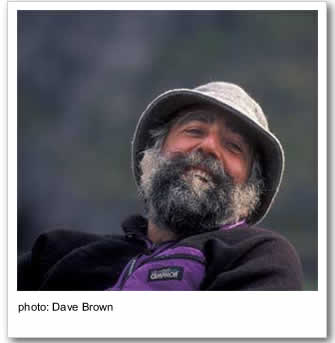 Ranch Arts Center, Appalachian Center for Crafts,
Arrowmont School of Arts & Crafts, Brookfield Craft
Center, Marc Adams School of Woodworking, Ernie Conover
Workshops and many other places. The weekend after our
meeting, March 28th-31st, he will be teaching hands-on
classes at Gene Colley’s Canyon Studios in Copper Canyon
near Lewisville.
Ranch Arts Center, Appalachian Center for Crafts,
Arrowmont School of Arts & Crafts, Brookfield Craft
Center, Marc Adams School of Woodworking, Ernie Conover
Workshops and many other places. The weekend after our
meeting, March 28th-31st, he will be teaching hands-on
classes at Gene Colley’s Canyon Studios in Copper Canyon
near Lewisville.
I consider myself a “bowl maker” more than a wood turner
because, although the turning process fascinates me, it
is the resulting bowl that commands my interest. From
the earliest times bowls have had meanings for people
beyond the purely utilitarian. The bowl as vessel has a
resonance deep within the human psyche. I have always
thought of each piece that I make as a composition
utilizing elements of pattern, line, weight, texture and
form. Even in the most simple pieces I try to find a
harmony of grain and shape. I seek a balance in my work
between the dynamic and the serene. By playing with the
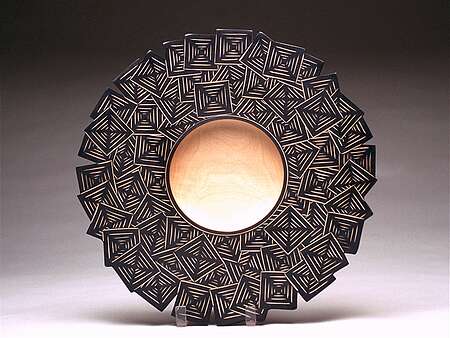 tension created by combining the circle’s perfection
with the energy of pattern I am trying to make pieces
that have life. I use patterns, whether created by grain
structure or organic fluting and carving or repeated
geometric shapes, to develop harmony in each of my
pieces. I find myself always looking for a new means of
expression within the turned form. --- Al Stirt
tension created by combining the circle’s perfection
with the energy of pattern I am trying to make pieces
that have life. I use patterns, whether created by grain
structure or organic fluting and carving or repeated
geometric shapes, to develop harmony in each of my
pieces. I find myself always looking for a new means of
expression within the turned form. --- Al Stirt
For the March demonstration, Al Stirt will make one of
his sgraffito (Italian for “scratched”) platters, where
he will turn a platter with a wide rim. He will paint
the rim and draw and carve a pattern through the paint
into the wood. The demo will incorporate turned beads
and coves (which require no sanding) as well as turning,
painting and carving.
|
|
|
|
|
|
|
February 2008 Program
|
|
"Making Wooden Jewelry on the Lathe"
|
|
presented by
Joel
Crabbe
|
|
|
Until 15 years ago, my life was a vagabond existence;
two foreign countries and 13 schools before I graduated
from high school. I was born a military brat, married a
military brat and had three military brats of my own. I
retired from the U.S. Navy in 1992 and realized that I
had the opportunity to pursue my woodworking hobby with
gusto. I discovered the lathe four years ago and soon
the building of square things yielded to the turning of
round things.
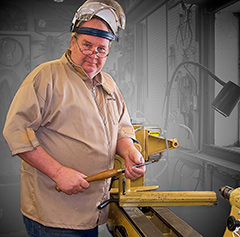 Our featured demonstrator for February, Joel Crabbe,
Our featured demonstrator for February, Joel Crabbe,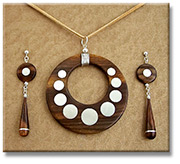 said that he turned his first pair of earrings about a
year ago and, “the ladies in my life: wife and daughters
gushed over this miserable pair of earrings and wanted
more”.
said that he turned his first pair of earrings about a
year ago and, “the ladies in my life: wife and daughters
gushed over this miserable pair of earrings and wanted
more”.
“Well, I’m not one to disappoint my ladies and I began
to explore the world of jewelry design using my lathe to
create basic shapes to be combined with other items to
create a one-of-a-kind piece of jewelry”.
Now days, Joel often finds himself at the costume
jewelry display at Wal-Mart getting ideas on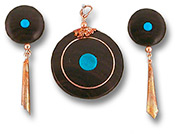 what designs are currently popular and collecting
baubles that have interesting elements that could be
cannibalized for his turnings. “I sure get more than a
few quizzical stares from other guys as they make their
way to the tool and automotive sections,” he says.
what designs are currently popular and collecting
baubles that have interesting elements that could be
cannibalized for his turnings. “I sure get more than a
few quizzical stares from other guys as they make their
way to the tool and automotive sections,” he says.
As he will show in his demonstration, Joel says that
from a technique point of view, making jewelry on the
lathe is not difficult and when you examine the
procedure closely, it consists of simple
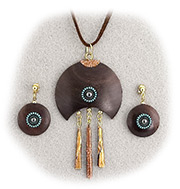 spindle work and face plate techniques. The creativity
aspect is in the combination of simple turned shapes and
other elements to create a pleasing piece of jewelry
that is unique and a creative process for him. He
describes the process as the lathe creating the bones
while his application of creativity and imagination
fleshes out the wearable art. His guidelines for turning
jewelry on the lathe are simple ... there is only one
rule in the creation of jewelry: THERE ARE NO RULES.
spindle work and face plate techniques. The creativity
aspect is in the combination of simple turned shapes and
other elements to create a pleasing piece of jewelry
that is unique and a creative process for him. He
describes the process as the lathe creating the bones
while his application of creativity and imagination
fleshes out the wearable art. His guidelines for turning
jewelry on the lathe are simple ... there is only one
rule in the creation of jewelry: THERE ARE NO RULES.
Joel Crabbe’s demonstration will introduce some of his
design concepts as he creates a simple earring and
pendant set in mesquite and sterling silver. The
completed set will be donated to the club as a
bring-back or raffle prize.
|
|
|
|
|
|
|
January 2008 Program
|
|
"Ornamental Lathe Turning"
|
|
presented by
John
Herber
|
|
|
Our
January 2008 program will be presented by John Herber,
one of our long-time members and will feature the
ornamental lathe that he designed and built. The program
will include historical information on the subject;
information on ornamental turning organizations;
pictures of some pieces of ornamental turnings (both
current and eighteenth and 19th century); pictures of
John’s lathe and work; and a demonstration of John
Herber’s lathe in action.
John retired in 1999 after working as a
electromechanical design engineer in the aircraft
industry for over thirty years. His interest in
woodworking started at an early age when he built a Soap
Box Derby racer in 1951. The car was built using
laminated construction and won the “Best Constructed
Car” award in the 1951 San Antonio Soap Box Derby. There
were approximately two hundred entries and the prize was
a fifty dollar set of Stanley hand tools, most of which
he still has and uses.
John is an avowed “thing maker” because he is frugal
(cheap). Most of the materials used on projects have
come from the scrap yard or have been salvaged from junk
either given or found. Purchased materials are the
choice of last resort. The ornamental lathe that he
built exemplifies this attribute. Among the many things
or disciplines He has done over the years are: lapidary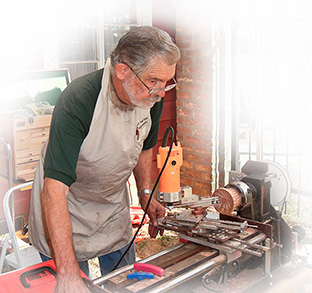 work (both cabochon and faceted); jewelry making (both
fabricated and cast); furniture making; house
construction; auto mechanic and construction; and
machine shop work. It was when he was into lapidary, and
a member of The Arlington Gem and Mineral Club, that he
first met two the future WNT members, Randy and Keith
Johnson, who, along with his own kids were junior
members of the club (early seventies).
work (both cabochon and faceted); jewelry making (both
fabricated and cast); furniture making; house
construction; auto mechanic and construction; and
machine shop work. It was when he was into lapidary, and
a member of The Arlington Gem and Mineral Club, that he
first met two the future WNT members, Randy and Keith
Johnson, who, along with his own kids were junior
members of the club (early seventies).
The Spring 2007 issue of American Woodturner had three
articles that are ornamental turning related. You can
find these articles beginning on page 40 and continuing
through page 53. These three articles are what inspired
John to build an ornamental lathe. After construction of
his ornamental lathe, he bought books on the subject and
has recently joined Ornamental Turners International
(OTI). This is somewhat the reverse of the order in
which this should be done. OTI is an international
chapter of AAW and has less than 200 members. They meet
once every two years alternating between the East coast
and West coast. The next OTI meeting will be in the fall
of 2008 near Saint Louis, Missouri. The OTI web site can
be found at:
http://www.ornamentalturners.org. This web site is
very interesting and can consume you for hours if you
are not careful. Another organization dealing with
ornamental turning is the Society of Ornamental Turners
(SOT). This is a primarily British organization. Their
web site is:
http://www.the-sot.com.
After John’s decision to make an ornamental lathe, his
wife, Lynne, has been a widow of the project. Most of
his time has been spent modifying, adding to, or
learning how to drive (operate) his ornamental turning
lathe.
John’s woodturning experience started in high school
industrial arts shop where his instructor was primarily
a basketball coach. He briefly owned a Shop Smith in the
early seventies where he scraped out some candle
holders. In 2002, a friend of his said “hey, John,
Harbor Freight has a neat wood lathe for $179. Let’s
each get one”. After that purchase, he had to figure out
what to do with that silly thing. He attended the
Woodworking Show in Arlington where WNT had a demo booth
and shortly thereafter was a member of WNT. He has
studied under Stuart Batty, David Ellsworth, Nick Cook,
and Larry Roberts; all renowned and world wide
recognized turners. He has done bowl turning, deep
hollow vessels, spindle turning, and pen turning. Much
of his equipment is home built. (in keeping with his
general philosophy).
|
|
|
|
|
November 2007 Program
|
|
"Turning a Snowman"
|
|
presented by
Marion
McDaniel
|
|
|
Wood
craftsman Marion McDaniel is a native of Georgia who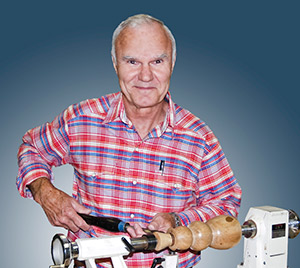 has resided in Dallas for the past thirty-five years. He
currently lives near White rock Lake.
has resided in Dallas for the past thirty-five years. He
currently lives near White rock Lake.
What makes Mr. McDaniel’s talent and artistry so amazing
is that he only began his work with wood a few short
years ago. After an on-the-job accident seriously
injured his back, he was forced to retire after
twenty-one years with Kroger Foods.
While recovering, he decided to whittle a cane for
himself since he now needed one to aid him in walking.
Prior to carving that first cane, he had never carved
drawn, painted, nor even doodled on paper. That cane,
however, was the beginning of a consuming pastime, and
he now spends his time crafting other beautiful works in
wood. Marion has turned and carved beautiful bowls,
bottles, canes, snowmen, and walking sticks from a
variety of fine woods, some with intricate inlay.
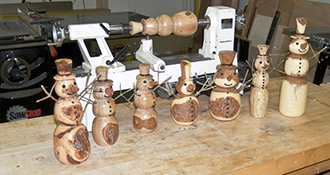
The holiday season keeps him busy creating his special
wooden snowmen, which are each carved from a single
piece of native Texas wood. At the November meeting, he
will be demonstrating his techniques for turning these
unique creations.
|
|
|
|
|
|
|
August 2007 Program
|
|
"Tools for End Grain Hollowing"
|
|
presented by
John
Horn
|
|
|
Most of us
know that a bowl gouge is the preferred tool for most
cross-grain bowl turning where the grain direction is
perpendicular to the length of the lathe bed. End-grain
turning, defined as the case in which the grain of the
wood is parallel to the length of the lathe bed,
presents a completely different challenge in both
turning techniques and tools used.
If you peruse the woodturning tool catalogs, you will
find that there are a wide variety of tools for sale to
solve all of the various difficulties encountered in end
grain turning. Some of these tools are complete systems
of components that are quite pricey to say the least.
When faced with this overwhelming variety of tools, how
is a person to decide which tool or system to select in
order to perform the task at hand? Is it necessary to
get a large loan at the bank just to turn a few end
grain vessels? Obviously, there are a large number of
options, some are relatively inexpensive and others are
very expensive.
By understanding the theory of how end grain wants to be
cut without
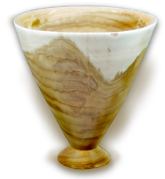 tearing out chunks of wood, both the tools and technique
choices become
tearing out chunks of wood, both the tools and technique
choices become
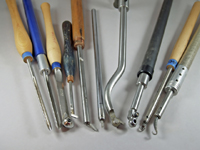 much more manageable. The August program will include
information about the features and limitations of most
of the end grain hollowing tools on the market and which
of those tools and techniques would be best suited for
different projects.
much more manageable. The August program will include
information about the features and limitations of most
of the end grain hollowing tools on the market and which
of those tools and techniques would be best suited for
different projects.
Educated as an instructor of high school musicians, John
spent a major portion of his life teaching a variety of
subjects from high school band and choir to adult
computer applications. Now he teaches regular classes at
the Woodcraft store in Addison and one-on-one sessions
on woodturning topics in his shop for beginning to
intermediate turners. When he is not teaching and
attending woodturning meetings, he stays busy turning
contract jobs for corporations and individuals on one or
more of his three wood lathes.
John is a member of the AAW and is active in both the
Woodturners of North Texas and the Golden Triangle
Woodturners.
|
|
|
|
|
June 2007 Program
|
|
"Ribbon Turning"
|
|
presented by
Steve
Ott
|
|
|
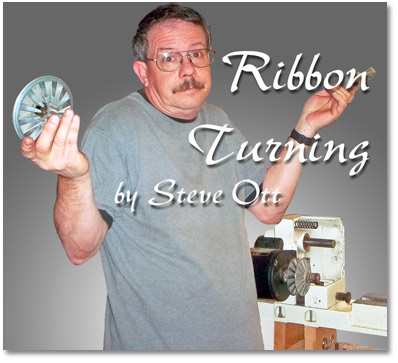 Our
demonstrator for the June, 2007 program will be our very
own Steve Ott who became seriously interested in ribbon
turning when he attended demonstrations by Malcolm
Tibbetts during SWAT 2005 in Wichita Falls. He attended
every one of Malcolm’s demonstrations and became
fascinated with what he saw. Here is his story about the
June program and his fascination with ribbon turning. Our
demonstrator for the June, 2007 program will be our very
own Steve Ott who became seriously interested in ribbon
turning when he attended demonstrations by Malcolm
Tibbetts during SWAT 2005 in Wichita Falls. He attended
every one of Malcolm’s demonstrations and became
fascinated with what he saw. Here is his story about the
June program and his fascination with ribbon turning.
Malcolm’s ribbon turnings were spectacular. Now I do not
pretend to be as talented as he is, but my demonstration
will introduce you to the world of ribbon turning.
In Malcolm Tibbetts words, “All you do is turn
bottomless bowls, cut them in half, and glue them back
together.” Well it may be a bit more complicated than
that, but not too much more complicated. If you are new
to segmented turning, an accomplished segmented turner,
or just have an interest in segmented turning, this will
open up entirely new avenues for you.
In “normal” segmented turning, you make flat segments,
which are glued together into a ring, and the rings are
stacked on top of each other into your desired shape. In
this “ribbon turning”, you add another element - a
slope. This then becomes stave construction for
segmented turning.
Although you can do this in the “normal” manner, it
might be harder to ensure the design matches in your
final construction.
I will attempt to show you how to make these turnings,
and just some of the shapes you can make by doing this. I will be using just one example - a
45 degree slope. By using different degrees for the
slope of your bowls, you will come up with entirely new
shapes. I will also describe some tips and tricks that I
learned the hard way.
make by doing this. I will be using just one example - a
45 degree slope. By using different degrees for the
slope of your bowls, you will come up with entirely new
shapes. I will also describe some tips and tricks that I
learned the hard way.
You start with a lamination that you have determined for
your design, cut this into compound segments, glue
segments together into a bowl shape, turn to final
shape, cut apart, reposition, and glue back together.
See how easy that was! Just seven easy steps!! Ha, Ha,
Ha. Seriously, it is not that difficult to do this, if I
can do it anyone else can also.
In the latest issue of American Woodturner, Malcolm has
written an article that describes this procedure in
detail. With his book, this article, and my demo, you
will have all the information you need to construct and
complete a one of a kind ribbon turning.
After my demo, I hope you will attempt this type of
turning. I think you will be pleasantly surprised with
the outcome.
Steve Ott
|
|
|
|
|
|
|
May 2007 Program
|
|
"Road Kill for Woodturners"
|
|
presented by
Kevin
Bassett
|
|
|
Our May
2007 program was presented by Kevin Bassett, a local
certified arborist with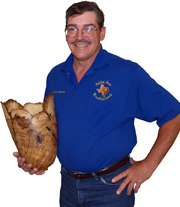 over thirty years of experience. Kevin made a PowerPoint
presentation about common north Texas trees suitable for
turning and how to identify them in either tree form or
as “road kill” for scavengers of wood. Kevin also
brought along one of his natural edge mesquite bowls
chosen for the June 18, 2006 “Photo of the Day” on the
AAW website:
www.woodturner.org.
over thirty years of experience. Kevin made a PowerPoint
presentation about common north Texas trees suitable for
turning and how to identify them in either tree form or
as “road kill” for scavengers of wood. Kevin also
brought along one of his natural edge mesquite bowls
chosen for the June 18, 2006 “Photo of the Day” on the
AAW website:
www.woodturner.org.
Kevin’s program presented a lot of information and tips
concerning what to look for in identifying various trees
by their bark and leaf structure. Questions from the
floor were answered with the expertise that amazed us
casual woodturners. His program also covered a number of
things to consider when selecting wood to turn, since he
is not only an arborist, but an accomplished woodturner.
|
|
|
|
|
|
|
April 2007 Program
|
|
"Tips on Turning Eggs"
|
|
presented by
Fred
Denke
|
|
|
The April
program will consist of the following two segments:
a review of the WNT entry in the 2000 AAW Collaborative
Project and a demonstration on turning an egg.
Fred Denke retired seven years ago from an engineering
career in the aircraft industry. He grew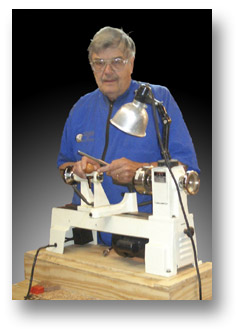 up on a farm in central Texas near Waco. As a farmer’s
son working with wood was part of farm chores. This work
let him use woodworking tools at an early age. In his
adult years he continued woodworking using hand tools
and a nine-inch table saw. This woodworking led to the
curiosity of woodturning, so after retirement and buying
a medium size lathe he was a woodturner.
up on a farm in central Texas near Waco. As a farmer’s
son working with wood was part of farm chores. This work
let him use woodworking tools at an early age. In his
adult years he continued woodworking using hand tools
and a nine-inch table saw. This woodworking led to the
curiosity of woodturning, so after retirement and buying
a medium size lathe he was a woodturner.
He has attended several “Texas-Turn-or-Two”, SWAT and
AAW symposia. He has spent a week at Arrowmont with
David Ellsworth as the instructor. He also has attended
all day hands on with Lyle Jamison, Stuart Batty,
Michael Hosaluk, Dick Sing, and Jacques Vesery.
Fred has led two AAW Collaborative Projects. The Coffee
Grinder at the 2005 Symposium in Kansas City, KS and the
Dirigible presented at the 2000 AAW Symposium in
Charlotte, NC.
The Dirigible has been selected for permanent display at
the Scottish Rite Hospital in Dallas. As part of the
April program, a review of the Dirigible project will be
presented.
For our April Demonstration, Fred Denke will talk about
his process in learning to turn an egg. The demo will
include turning a egg using a template as a guide and a
holding jig for finishing the ends.
|
|
|
|
|
|
|
March 2007 Program
|
|
"Finishing for the Home Shop"
|
|
presented by
Howard
Hale
|
|
|
Howard Hale, of Dallas, will
present a very informative and entertaining presentation on "Finishing for
the Home Shop" for our March meeting. Howard brings 22 years of professional
woodworking experience to the Dallas Woodcraft store. He was a student of
the great Danish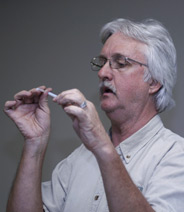 woodworking master, Tage Frid, and brings a unique style of teaching that
everyone enjoys.
woodworking master, Tage Frid, and brings a unique style of teaching that
everyone enjoys.
His hands-on approach helps students learn everything
from power tools to hand tools to applying fine finishes.
His classes include: Raised Panel Doors, Mortise and
Tenon Joinery, Hand-cut Dovetails, Hand-tool Basics, Building a Smoothing
Plane, and his premier class; Finishing for the Home Shop is a must take by
everyone.
Along with his own classroom activities, Howard is in
charge of the Education Program at the Dallas Woodcraft store. He schedules
all classes and sets up the Second Saturday Free Demo Days.
|
|
|
|
|
|
|
January 2007 Program
|
|
"Turning a Covered Dish"
|
|
presented by
Tom
Crosby
|
|
|
C. Tom Crosby is a multi-talented woodturner as one can
readily tell by visiting his personal gallery space on
the East Texas Woodturners website to see the diversity
in his turnings. Tom will be the demonstrator for our
January 2007 program and the topic will be "Turning a
Covered Dish".
Tom Crosby was born and raised in Vicksburg,
Mississippi. Tom retired from the U. S. Army Corps of
Engineers, in 1995 after forty years of service. He and
his wife Marjorie relocated to Van Zandt County near the
small town of Canton, Texas.
Tom has been working with wood since he was a
youngster making boxes, furniture, cabinets, and has
built two houses. His interest in woodturning began in
1999 when he got his first lathe and fell in love with
woodturning. He makes segmented bowls, hollow vessels,
pierced vessels, vases, boxes, urns, platters, cups,
inlaid bowls and various other pieces. Two of his pieces
were featured in the Members’ Gallery of the Winter 2003
edition of the American Woodturner. His pieces have won
several awards, including the top award in the 2004
Rockler’s National Turning Contest. In the Spring 2005
(Issue No. 5) of Woodturning Design, there is an article
by Tom on a method developed by him for turning a One
Piece Cup with a Handle.
Tom and Marjorie serve as librarians for the East
Texas Woodturners in Tyler, Texas. Tom served as the
2003 -2004 President of the East Texas Woodturners Club.
He is a demonstrator and mentor and has demonstrated at
numerous other clubs and the 2004 and 2005 South West
Association of Turners Symposium. He is also a member of
the Dallas Area Woodturners and the American Association
of Woodturners.
Tom says that woodturning gives him a chance to
explore his artistic side and that when he picks up a
piece of wood he can’t wait to see what is hidden
within. He is an avid conservationist and feels that
this is a way of recycling by using wood from trees that
have been cut or must be cut because of disease or some
other reason.
|
|
|
|
For a
handout of this program in Adobe PDF format, select the
following link (left-click to view online or right-click
to download):
Turning a Covered Dish.
|
|
|
|
|
Links to Archived Programs
|
|
|
|
|
|
|
|
|
|
Copyright © 2005,
2006 2007, 2008 Woodturners of North Texas
Last Updated
01/07/2009
|
|
